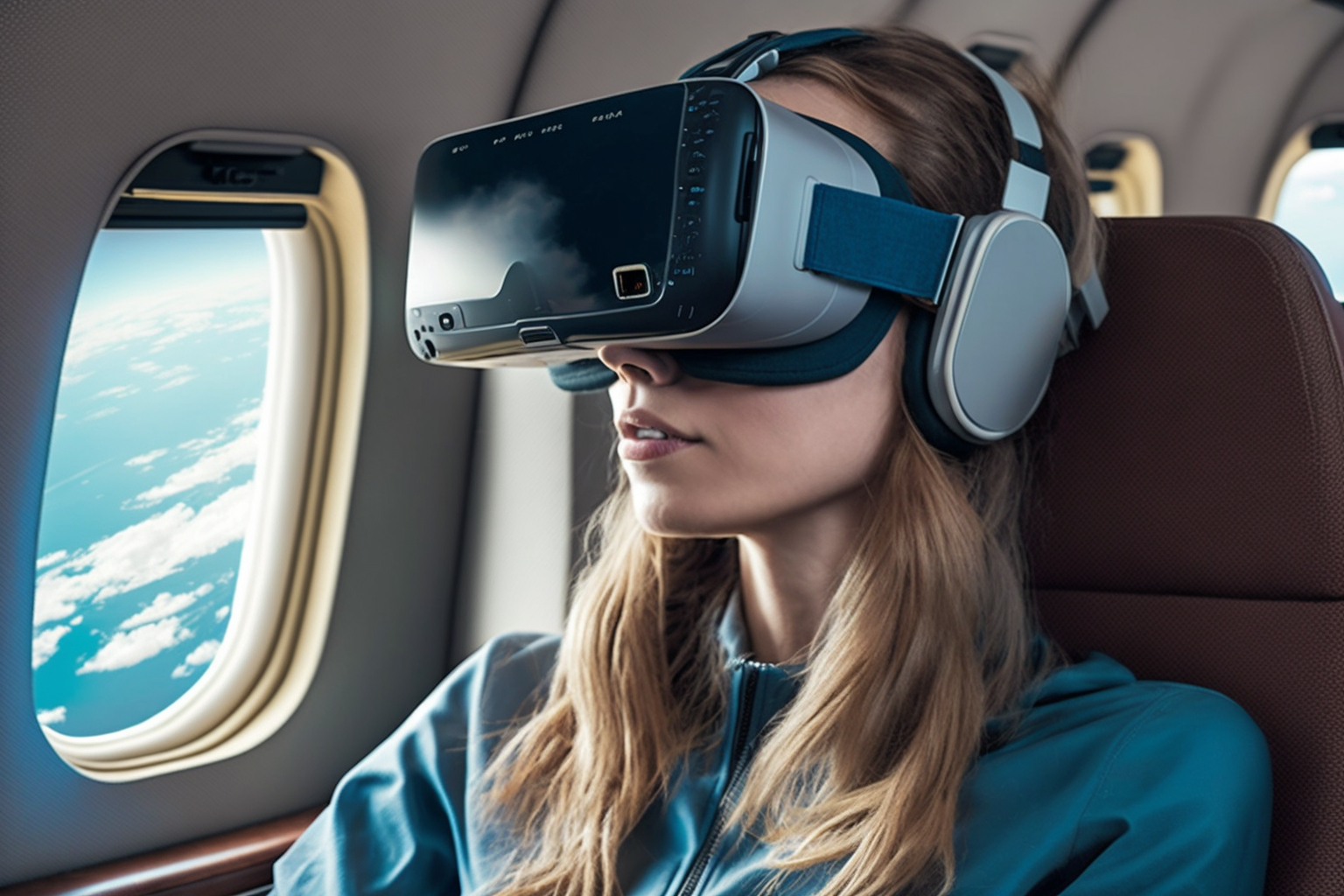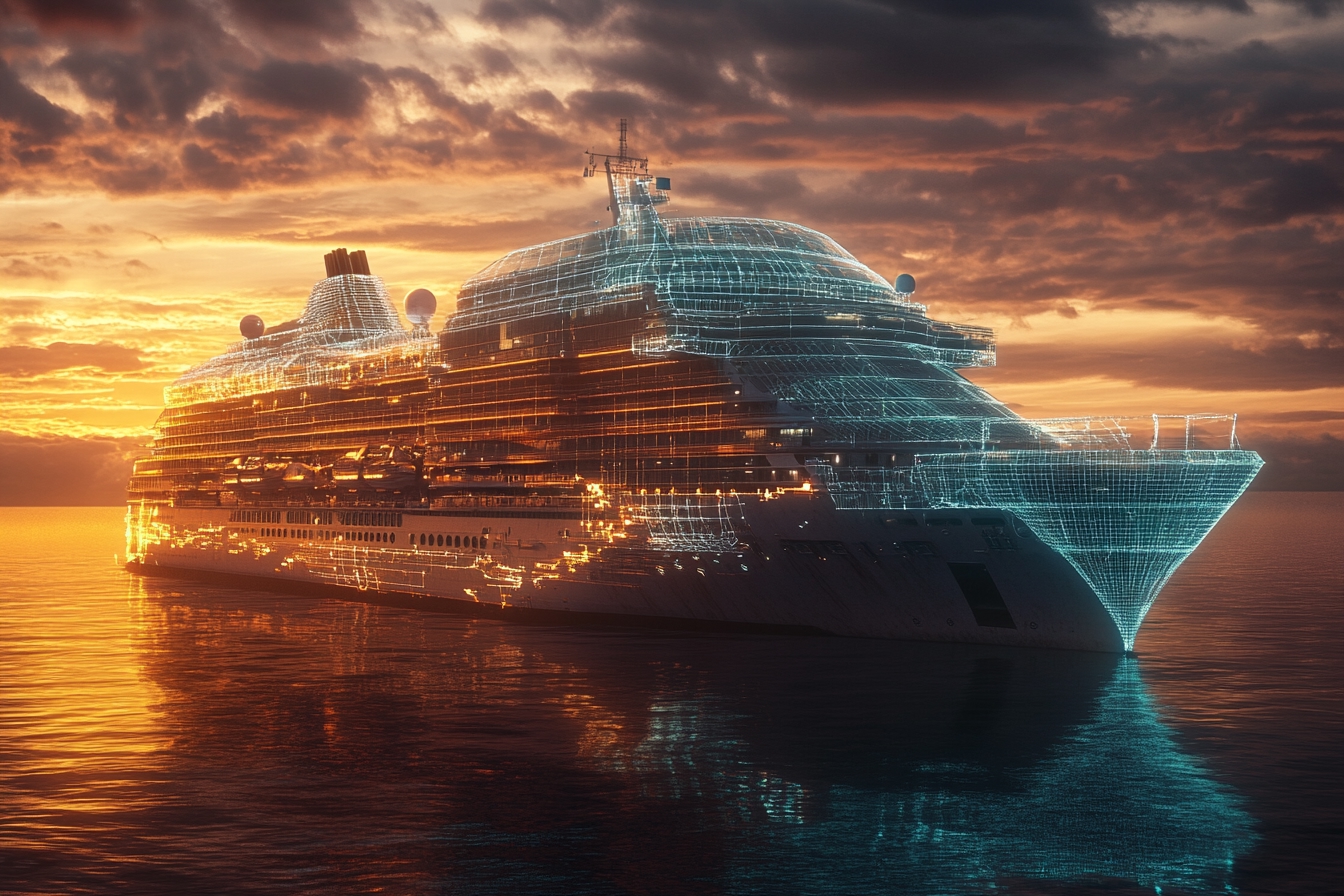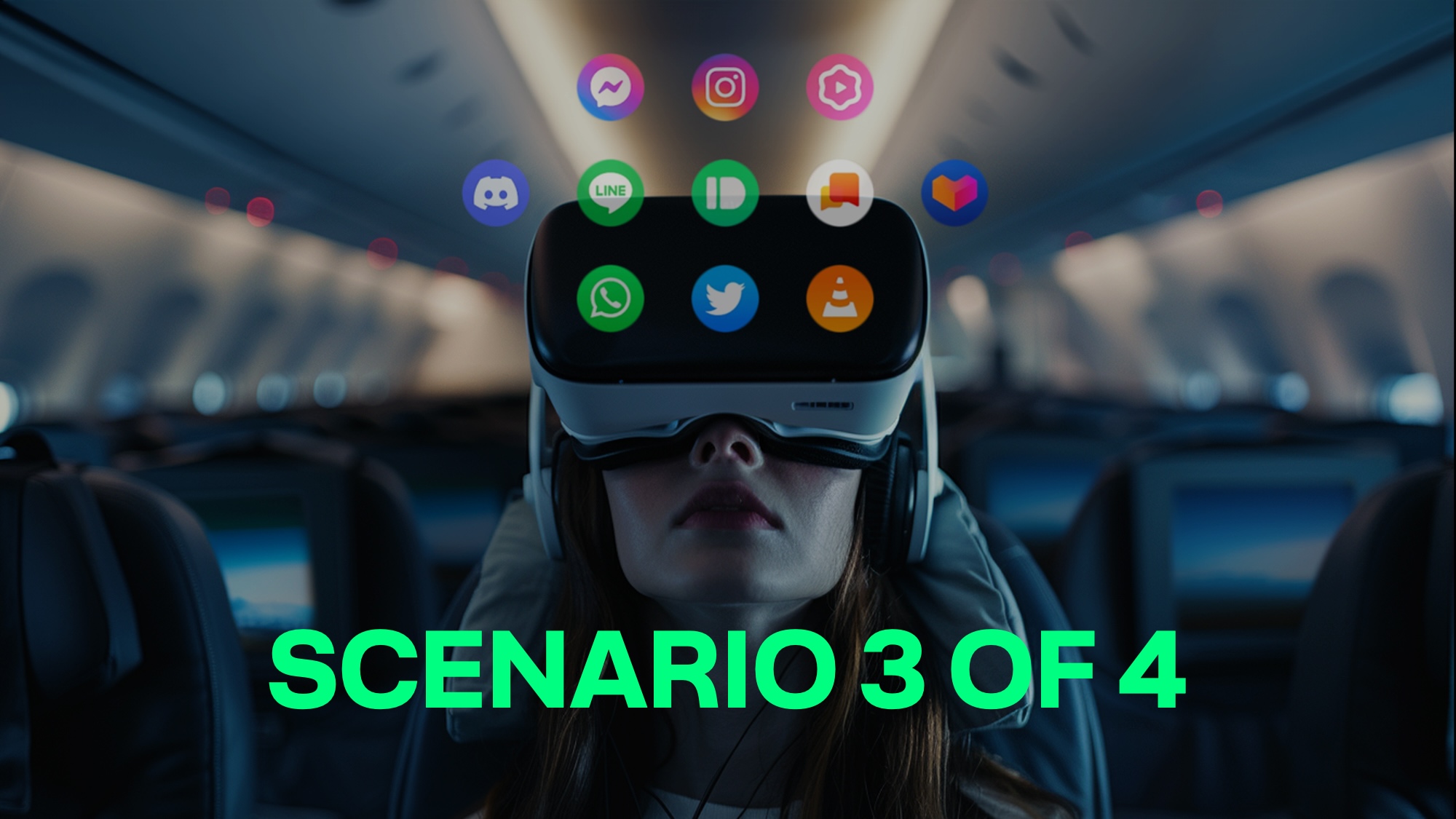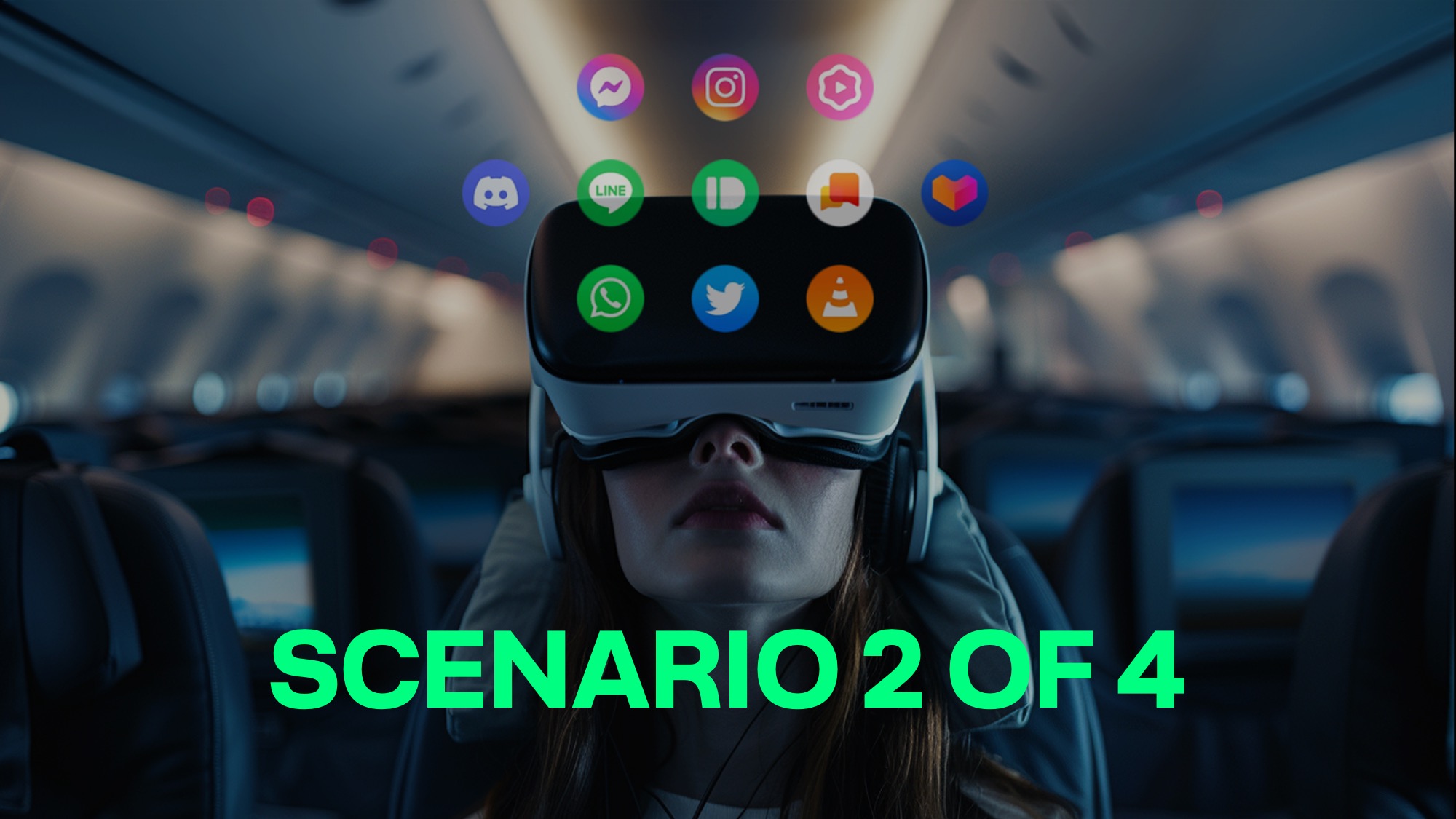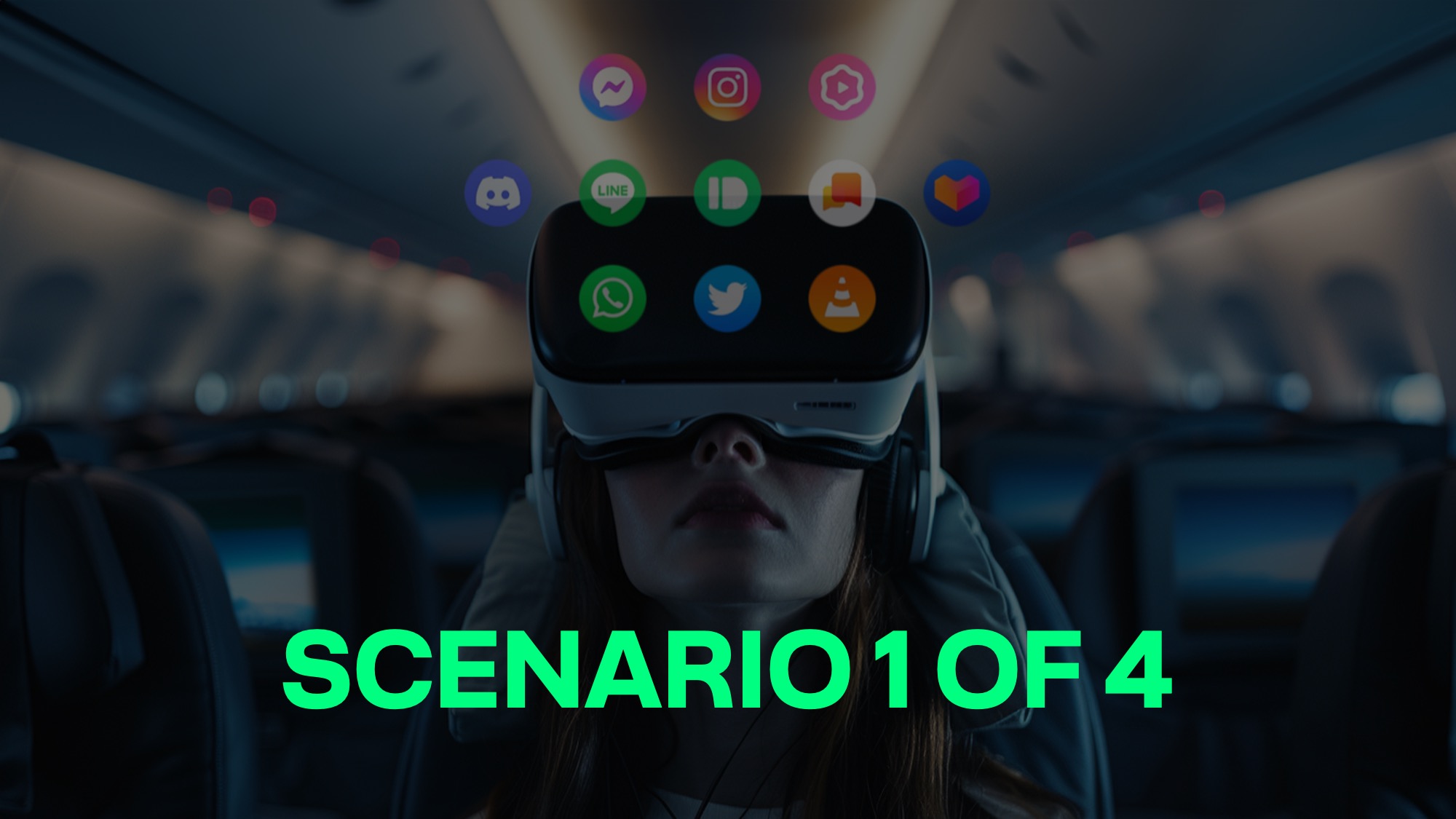This is the second part of our article series decoding the future of the metaverse for the travel industry.
In Part 1, we laid the foundation by doing three things:
- We charted the spiraling interest in the buzzword “metaverse” that started in late 2021 and commented on its demise in popularity across the following year.
- We took a closer look at 2022 and outlined the most interesting experiments and product launches by travel brands applying immersive technologies in the travel context. For instance, we looked at Qatar, which launched its Qverse, and Singapore-based Millennium Hotels, which launched the first-ever hotel in the metaverse (specifically, in Decentraland).
- Thirdly, we also illustrated how the travel industry saw more and more activity in the broader Web3 space, with travel-specific players like Chain4Travel, for example, raising significant funds in 2022.
In today’s post, we want to take a step back and look at the metaverse movement from a more strategic perspective.
- What exactly is the metaverse?
- Do we already see any meaningful metaverse-like applications in the travel industry?
- And what is the true value of the metaverse when it comes to making travel experiences better in the long term?
Answering these fundamental questions is mission-critical in order to bring more clarity to the heated debate about the relevance and applicability of the metaverse, specifically in the travel context.
Before getting into the specifics of these questions, it is important to state the obvious: most people have no idea what the term metaverse actually means.
The metaverse is still an elusive concept to most
In recent years, the concept of the metaverse has gained significant attention, particularly within the technology bubble. However, a quick Google Trends analysis reveals that most people are still unfamiliar with the term, making it an elusive and enigmatic concept for many.
To demonstrate the full extent of this unclarity, it’s worth noting that:
- 57% of people that search for “metaverse” on Google also look up “what is metaverse.”
- And 45% of metaverse Google searchers actually type in “metaverse meaning.”
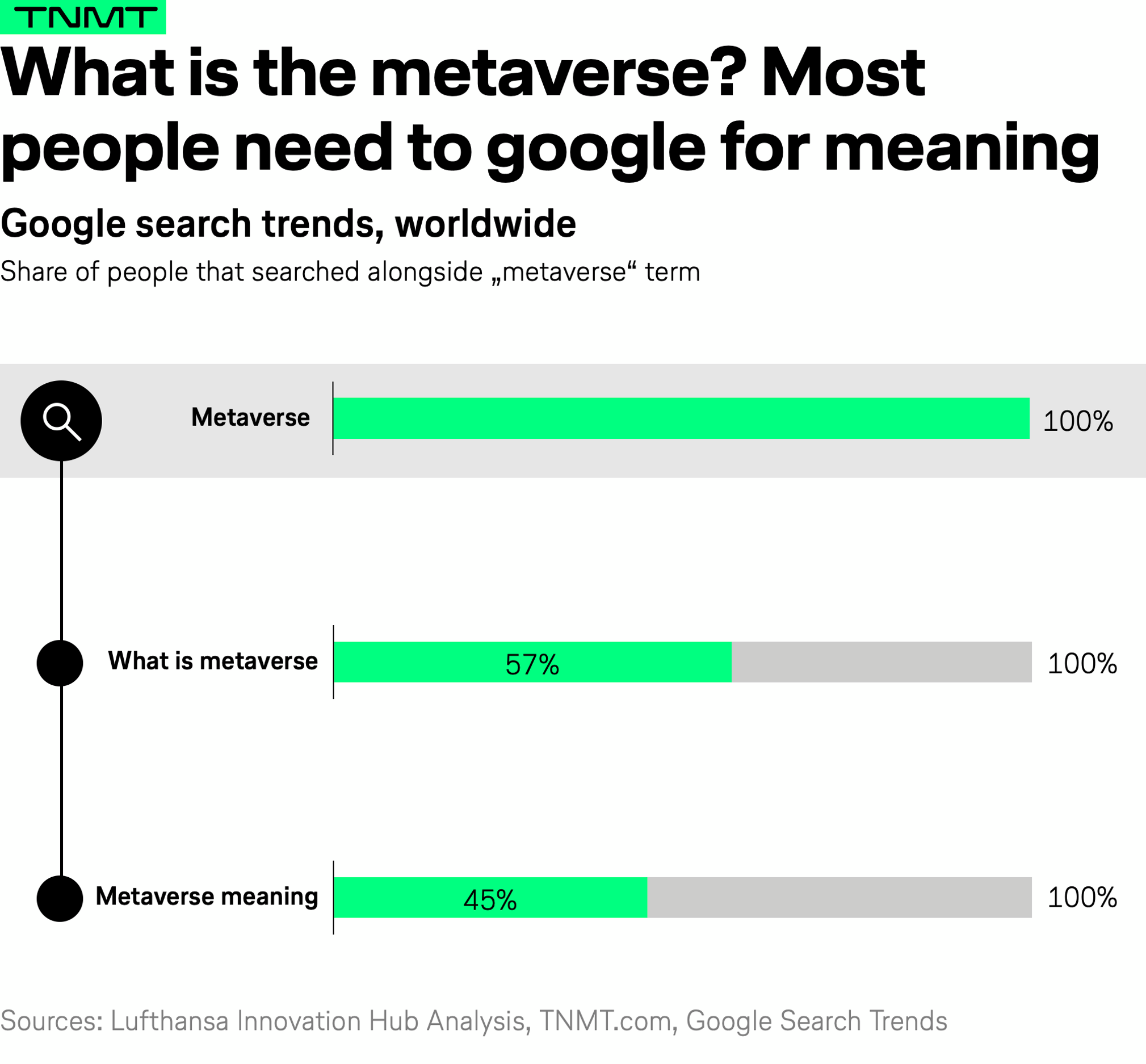
Given these numbers, it’s fair to assume that most people interested in the metaverse look for basic explanations of what the term actually means.
This proves that there is a clear need to demystify the metaverse.
In this deep dive article, we aim to clarify the concept, shed light on its significance, and consider the possible ways through which it could revolutionize the world of travel.
Metaverse Unveiled: Debunking major myths
So, let’s actually start with a basic description of the metaverse concept (without going into any travel-specific applications yet).
Most definitions agree that the metaverse has something to do with 3-D virtual worlds, the internet (or another version thereof), revolves around social interactions, and maybe even spatial computing in the form of holograms, VR, or something closely related, right?
This is correct, but the term means so much more.
- The concept of the metaverse describes an alternate digital/virtual universe. Typically, one imagines a virtual replica of our physical world, but in the digital space with human-like avatars, virtual streets and houses, virtual fire hydrants, and virtual dogs peeing on them.
- It represents a collective, shared digital space that blurs the boundaries between virtual and physical realities. While 3-D virtual environments are an integral part of the metaverse, it also comprises various interconnected platforms, applications, and technologies.
- Social media, online gaming, augmented reality (AR), virtual reality (VR), and blockchain-based systems are some of the key components that contribute to the diverse and immersive nature of the metaverse. These elements come together to create a highly interactive, user-driven experience where individuals can engage in a multitude of activities, ranging from socializing and entertainment to commerce and education.
Thus, the metaverse represents a broader, more comprehensive vision of a seamlessly integrated digital ecosystem that extends beyond the confines of 3-D virtual worlds.
That’s also why the metaverse is often described as “an immersive version of the internet.” Think: where do you spend most of your time these days? Where do you shop? Where do you communicate? Chances are, it’s most likely the internet. And if not: I congratulate you; you are a rare specimen of a human and probably a dying breed.
In summary, the metaverse is a future in which immersive technologies touch on all areas of life and enable us to conduct real-world activities in a more intuitive and convenient manner.
Now that we’ve described what it is on a (buzzword-heavy) conceptual level, let’s get right to the nitty gritty and debunk some of the common myths around the metaverse.
Myth #1: The metaverse is a new kind of social network
A lot of the time, metaverse platforms are promoted as a new and better kind of social interaction platform. Instead of messaging your friends on WhatsApp, WeChat, or Telegram, you can now have your avatar walk up to your friend’s avatar and, well, talk to each other (or, more likely, type your conversation and have them visualized in funny-looking speech bubbles).
The most prominent example of this metaverse was Facebook’s, aka Meta’s, metaverse, which was promoted as “the future of connection” and “a new way to connect and share experiences.” As one of the pioneering platforms of social media, this understanding has had a tremendous impact on how the general public perceives the metaverse.
Surprisingly, it did not turn out to be a game changer and did not deliver a truly immersive metaverse experience.
Why?
As explained above, the concept of the metaverse is more than just a new platform for social exchange.
Let’s look at some of the better early-stage metaverse applications. You might have heard of metaverse blockchain gaming platforms like Decentraland or Sandbox. These platforms usually have a few things in common which, in our opinion, constitute the bare minimum for a functioning metaverse. For instance, they:
- Have a high degree of transactionality, meaning users can easily exchange goods on the platform via an in-game currency or token.
- Incorporate principles of asset ownership by allowing users to create and own digital assets. In blockchain-based games, this is typically done in the form of NFTs.
- Provide a platform for social interaction between players, with users able to create virtual personas (avatars) and move around freely in a digitally created environment.
So, in addition to avatars moving around, and the social interaction component, these platforms have two key components that we don’t see often in most of the so-called metaverses of today: the ability to conduct transactions and the ability to own assets. Granted, Decentraland and Sandbox are gaming concepts, and all activities within these metaverses relate to the game.
So, we’re still facing the issue of these platforms delivering a fragmented experience that only applies to a niche market and is not relevant across other areas of life.
However, it wouldn’t be the first time in history that a technology platform moves from a fragmented and niche proposition to universal adoption.
Think of how the Internet was initially conceived:
- The first versions of the Internet were disparate computer networks developed for the purpose of information exchange in the sciences.
- In the decades to come, this technology advanced to the point that research organizations across regions, and later, across the globe, started developing protocols to communicate with each other.
- Then, in the early 1980s, we witnessed the introduction of the personal computer and with it, the dawn of the standardized network protocols that we now call the Internet.
Looking at the metaverse, we now see the beginning stages of a similar development:
- Today’s metaverse use cases and platforms are typically fragmented and limited in their applicability.
- However, with immersive technologies and (the ability to access them) advancing rapidly, who is to say they will not touch on all areas of life eventually?
- Similar to the internet, which emerged as a means of exchanging information and later evolved to support many of our daily activities, the metaverse will provide support across all areas of life where a deeper level of immersion is beneficial.
Myth #2: VR = Metaverse
Let’s move on to the second myth.
Many people falsely believe that the metaverse is just a new term for what has long been known as Virtual Reality (VR).
This is wrong.
Yes, the products labeled “metaverse” today are typically based on VR. However, that doesn’t mean it’s true to the concept. As we discussed above, the conceptual metaverse is more than a digital world that lets users walk around in a digital space; it’s intended to support activities like transactions, commerce, and searches for information, thereby combining an array of technologies.
To enable the adoption of this new type of infrastructure, a number of technologies are incremental to the development of the metaverse.
In the future, these technologies will work together in tandem and enable immersion at scale. Important technologies include:
- 5G: the underlying network infrastructure required to supply users with high-definition and real-time access to an immersive virtual space.
- VR: a simulated 3D environment that enables users to move around in a 360-degree digital space, typically via the use of headsets.
- Spatial computing: to create a sense of movement within these virtual environments.
- AR (Augmented Reality): Technology that allows digital images and information to be displayed onto the physical environment, typically using a device like a mobile phone.
- Headsets and other interfaces: VR headsets like the Oculus Rift or the Meta Quest are just the starting point of what human-computer interaction gadgets can do. For instance, a new trend is the development of haptic gloves that let users feel and touch their surroundings in a virtual environment.
- Holograms: Currently still a niche technology often conceived as belonging to the realm of sci-fi, holographic technology is not as futuristic as one might think. In fact, innovative start-ups like Light Field Lab and Holoconnects are producing and commercializing the technology as we speak.
- Web3 and blockchain: Virtual worlds can be created without blockchain. However, there are some distinct advantages to utilizing blockchain as a network infrastructure, specifically, to support unique identities, record proof-of-ownership, and enable seamless transactions by way of fungible and non-fungible tokens (NFTs).
- NFTs and tokenization of assets: to create tradeable digital assets in the digital space, a transferable record of purchase, and a unique identifier for digital assets.
- AI and Generative AI: yes, Generative AI is also in the mix. In the same way that Generative AI will disrupt our search behavior on the current version of the internet, it will also disrupt how information can be searched for in a theoretical metaverse. Moreover, Generative AI can be used to generate imagery too, which is an important feature for interacting with a virtual environment.
Myth #3 – The metaverse exists already
As we explained before, the metaverse is still a futuristic concept in its early stages of development.
But it doesn’t exist yet.
Don’t let them fool you. By now, you should have realized there is no single platform out there that can do all the things we’re saying a metaverse can, or rather, should be able to do.
Although there are numerous components and technologies that hint at the potential of the metaverse, it is essential to recognize that it does not yet exist in its fully realized form. The primary reason for this is that the seamless integration of various digital platforms, applications, and technologies has yet to be achieved.
Currently, many virtual worlds, social media platforms, and gaming environments operate independently of one another, with limited interoperability. Additionally, while virtual and augmented reality technologies have made impressive advancements, they are still evolving, and their mass adoption faces challenges, such as high costs and accessibility issues.
Consequently, the metaverse remains an ambitious vision for the future, with ongoing technological advancements and collaborative efforts driving us closer to its eventual realization.
The crucial elements of a true metaverse
In our view, a true metaverse should go beyond merely facilitating immersive communication.
As mentioned earlier, a comprehensive metaverse needs to support transactions, asset ownership, and social interaction—these are the essential technical aspects that a metaverse must offer.
However, we must also address the “why”—why should users and businesses engage with the metaverse instead of the physical world?
The key lies in the intrinsic benefits that the metaverse provides to both users and businesses. These advantages stem from various use cases that we currently see in immersive technologies within the travel industry.
While today’s applications usually fall into one or two use case areas, a complete metaverse should be able to support and integrate all of these areas within a single platform.
In essence, the metaverse’s value comes from its ability to offer unique advantages and experiences, enhancing our interactions with the digital and physical worlds, and providing users and businesses with compelling reasons to embrace this groundbreaking technology.
The use case areas we see for the application of immersive technologies are essentially the following:
- Elevation: elevate or support the physical (real) world experience by way of immersive technologies. A related use case could utilize VR, AR, any combination thereof, or even holograms (yes, holograms—go here for an example); the key purpose being to provide a value-add to the physical experience or product.
- Replication: replicate the physical world and key characteristics thereof, but in the digital space. After all, immersion is only intuitive if we can connect it to our physical reality.
- Virtualization: virtualize key activities and thereby substitute elements of the physical experience. This can include training activities that take place in a virtual space instead of a physical space or a booking and transaction infrastructure to substitute existing channels.
And there is probably lots more to come than we can imagine today: let’s face it, nobody knows exactly what will be possible in the future.
In summary, the metaverse will likely evolve in new and unimaginable ways – and this is why, in our framework below, the Fully Realized Metaverse is a space that encompasses all-purpose areas in addition to the real world.
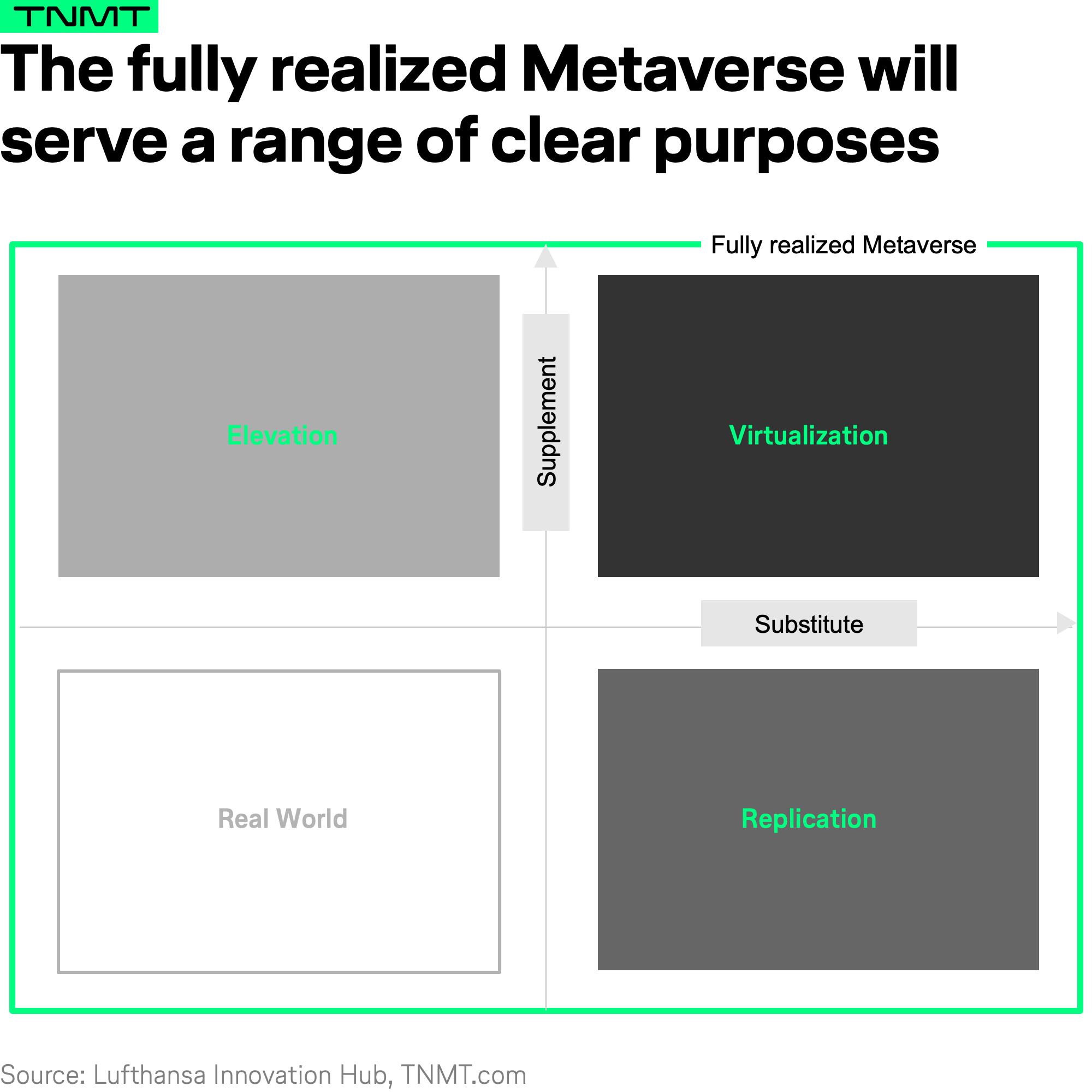
Today’s wannabe metaverse applications
Given this definition, a true metaverse combining all of these purposes is still many decades away.
Many of today’s so-called metaverse projects, while contributing to the development of the metaverse concept, can primarily be categorized as either Elevation, i.e. using immersive technologies like VR or AR as an add-on service or marketing product; Virtualization, if key activities like transactions and bookings, training experiences, are enabled in a virtual setting; or Replication, as in the case of digital twins. The latter refers to replicas of physical assets, processes, systems, or environments by using data, digital models, and simulations to mirror their real-world counterparts accurately.
These technologies, though impressive in their own right, represent individual components of the metaverse rather than the fully integrated digital ecosystem that the term implies.
Here is a quick example
To explain better, here is an example: Airport wayfinding via a mobile app is a form of augmented reality. In this context, AR enhances the traveler’s experience by overlaying digital information, such as directions, gate information, and points of interest, onto the physical environment. This helps passengers navigate the airport more efficiently and can improve their overall travel experience.
Similarly, some airports offer virtual reality environments that are also meant to assist customers in wayfinding, searching for points of interest, etc. These are applications that are provided as an add-on to the physical experience of being at an airport and fall within the category of Elevation.
Here is another example
Going beyond this easy example, some virtual reality projects or augmented reality products are not just meant to be an information service like wayfinding. Instead, they can substitute certain physical activities. For instance, a virtual or augmented environment can support asset ownership or transactions, like shopping for goods or minting NFTs for these goods to assert asset ownership. We can categorize this as an immersive experience with Virtualization elements.
In summary, most of today’s so-called metaverse projects are primarily forms of VR, digital twins, or AR experiences, and are very limited in what they can do.
Mapping today’s travel projects
To make this limited interpretation of the metaverse even clearer, let’s look at some of the real-world examples from the travel industry that have branded themselves as “metaverse” thus far and map them along our metaverse framework.
You will see that most of them play in one of the buckets described above.
But none of them are ready to expand beyond these isolated areas.
Let’s start with Elevation
On the customer-facing side, we’ve seen a few early examples of airlines using elevation forms.
For instance, Emirates launched a VR app for Oculus Rift, Qatar released its QVerse, and Lufthansa created various VR initiatives, including a VR video to upsell customers to premium economy at the gate, as early as 2017.
Similarly, many airlines have experimented with in-flight VR, among them Qatar.
These applications typically fall within the Elevation area in our framework as they aim to supplement the physical product (the flight).
- In-flight VR typically tries to enhance the entertainment options on board.
- Applications like the Qverse and Emirates’ VR app aim to provide better insight into how the product looks and feels, for example, what the seat looks like, if it goes back all the way, and how much space there is around it.
Simply put, these applications help invoke a “Try before you buy” strategy with upsell impact.
Aside from airlines, we’ve seen a number of travel players experiment with Elevation applications for the customer experience. Most of these applications have one thing in common: they visualize spaces, products, and information that users would otherwise not have access to.
This can be beneficial for a number of reasons, among them the inspiration, sales, and booking experience. Also, it can support individual travelers during their trip, for instance, as a virtual receptionist to facilitate your check-in process, or a virtual guide to supplement the physical travel and hospitality experience.
And these types of applications do not necessarily rely on AR or VR, but can also utilize other types of technology, like, holograms.
One such example is the hotel chain Aiden by Best Western. The chain is opening 30 boutique hotels in Scandinavia and is reportedly equipping all of them not with human receptionists, but with holograms.
The first hologram was installed in February 2023 in the Aiden Hotel in Herning, Denmark, and is intended to support guests when checking in and looking for hotel-related information.
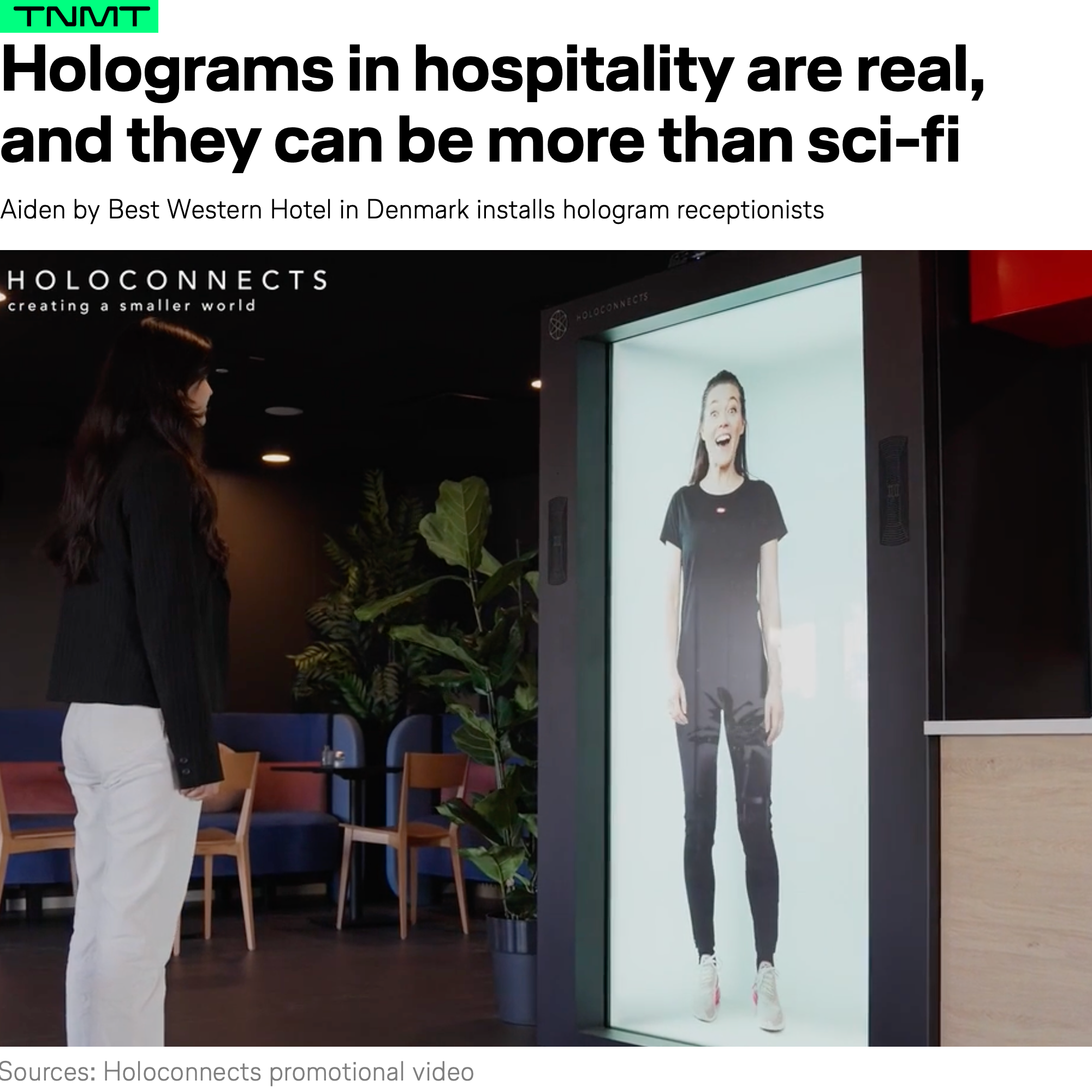
And while skeptics will argue that these experiences are gimmicky and rarely engage enough to really make a difference, the expectations of immersive technologies are more ubiquitous than one might think. According to a recent Booking.com survey, 42% of surveyed travelers report that they will be turning to virtual reality to inspire their vacation choices in 2023.
In line with this interest from the consumer side, we’ve seen a number of immersive experiences for inspiration, marketing, and upsell emerge. Many hotels are providing VR tours of their properties. The point is the same: after all, why choose the presidential suite over an executive suite for half the price? Simple: because it just looks that much cooler (and you can afford it).
Thanks to the upsell potential of providing this kind of immersive experience, hotel groups like NH Hotels and IHG are investing in state-of-the-art digital tours to showcase their properties and rooms.
And these kinds of tours can be implemented beyond the point-of-sale too. For instance, a number of Tier 1 museums are pioneering VR and AR to create more interactive experiences: New York-based MoMa now hosts immersive museum tours specific to exhibitions and artists, and the Louvre in Paris launched its first VR project titled “Mona Lisa: Beyond the Glass,” and even the Vatican museum provides virtual tours of major sights like the Sistine Chapel.
But as mentioned before, all of these use cases sit firmly within the realm of Elevation.
They aim to enhance the search experience or supplement physical travel activity.
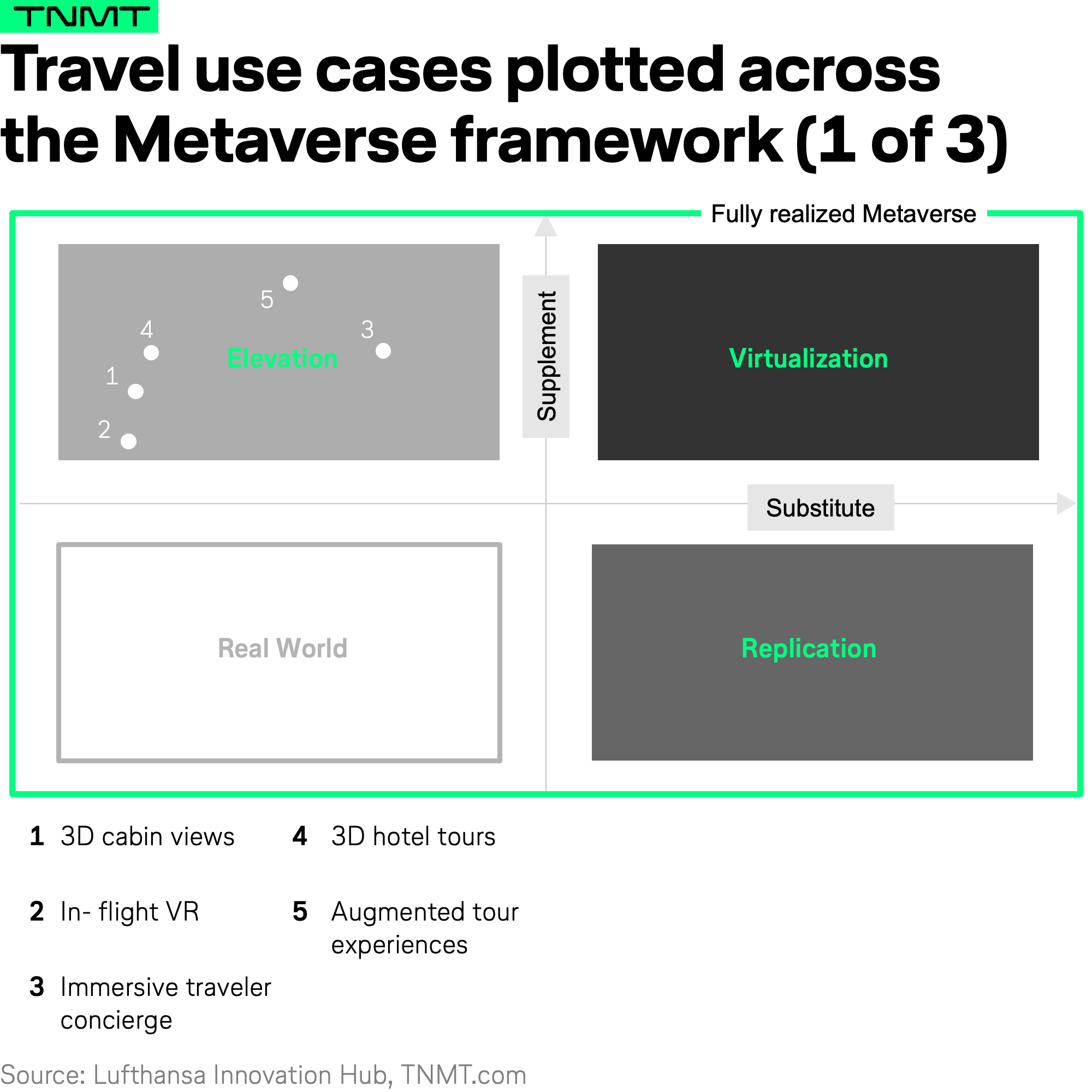
Virtualization is next
Often overlooked in public discussion are the technologies that are applied behind the scenes. For instance, airlines have been using simulations for training purposes for decades.
- Prime examples today are AR and VR for maintenance and repair operations (MRO), and for pilot and crew training.
- For instance, Lufthansa has its own VR Hub for aviation training, and in 2020, KLM announced that its subsidiary KLM Cityhopper would be introducing VR training for pilots.
- Others have launched applications for training MRO personnel using immersive technology, among them Japan Airlines, and KLM in cooperation with the Netherlands Aerospace Center, Australian airline Jetstar, and China Southern Airlines.
And this trend only shows signs of increasing relevance. For instance, Emirates announced it would hire 4,000 cabin crew members to train virtually from 2022 on.
Importantly, MRO is one of the most crucial operations within an airline’s value chain. After every landing of a passenger aircraft, an MRO engineer must perform a thorough aircraft inspection. This can take more than 200 individual steps, all of which are typically tracked on a bulky stack of papers where the engineer ticks off individual tasks. Therefore, it comes as no surprise that airlines are looking for ways to streamline and virtualize the process.
China Southern did not just use AR for training purposes but also as a tool that engineers can use in their daily operations. For instance, the airline’s AR glasses provide step-by-step multimedia support during the execution of maintenance activities. Using image recognition, the glasses can identify key parts of the aircraft and provide engineers with related information. The potential of these types of applications is huge, especially when combined with Generative AI, which means using language-based models to provide support information in a conversational manner or generate imagery related to the query on the fly.
While augmented MRO is not intended to substitute the role of engineers in MRO operations, it does virtualize parts of the process, specifically the search for information, the analysis of potential issues, and potentially even the record-keeping.
Hence, it is a very sophisticated version of Elevation in that it supplements the physical activity, while virtualizing key components thereof, which is why we categorized it under Virtualization.
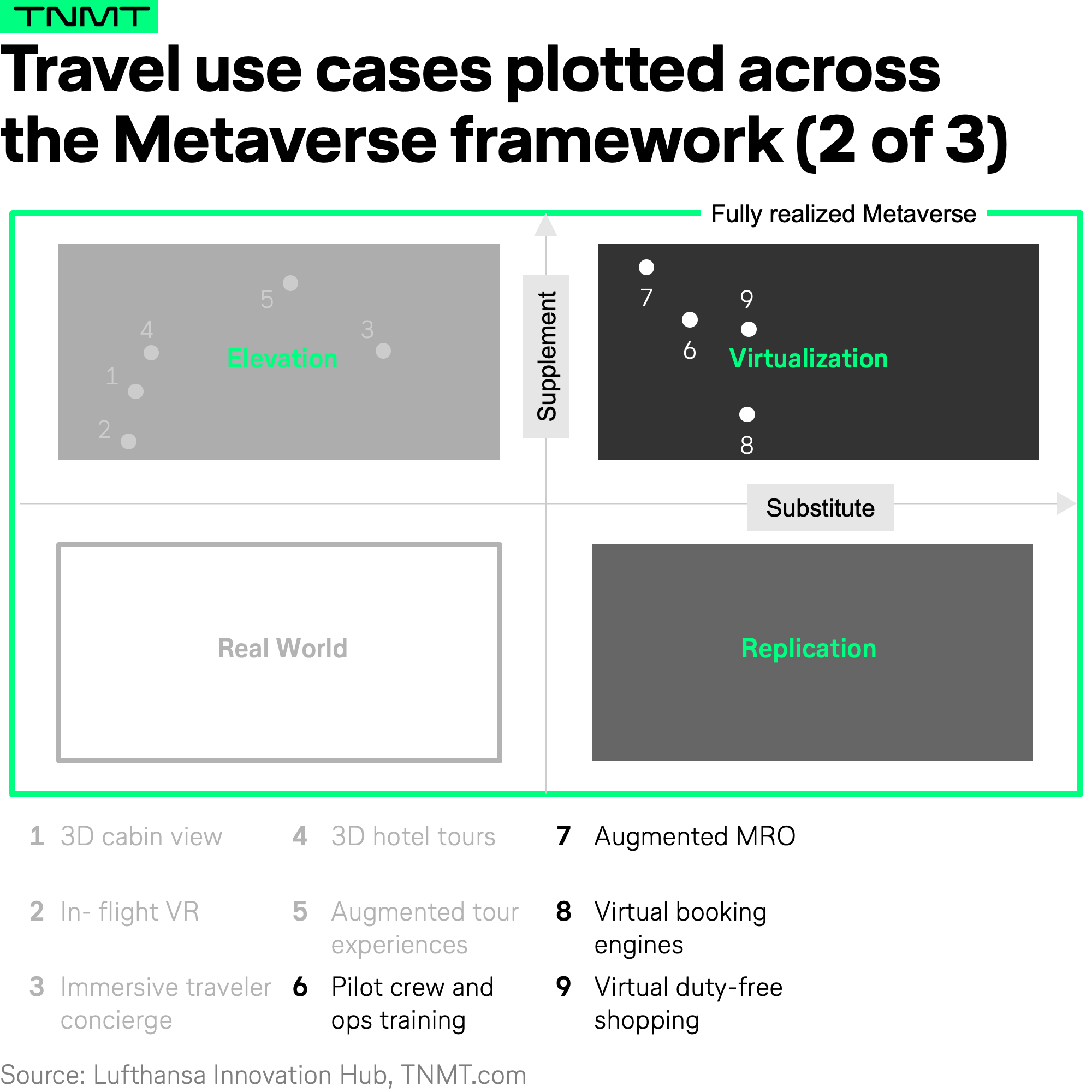
Outside the realm of aviation, examples exist within the Virtualization area, too. For instance:
- Immersive hotel tour tech provider Hotelverse is developing a booking engine on top of the virtual hotel tours it creates. This booking engine will allow users to search for rooms based on specific room attributes, then book the room directly within the virtual environment.
- Korean duty-free retailer Lotte showcased the first version of its “LDF Tower” at CES in January of this year. This platform is a virtual shopping space for duty-free products. Currently, it lets users test products, i.e., try on clothes and accessories on their avatars in the virtual space. This is a classic Elevation case. However, it aims to advance this platform to support orders and payments, i.e., virtualize the entire shopping process by enabling the transaction and purchase process in the virtual environment.
Again, these types of applications are not just simple Elevation, but they fall into the category of Virtualization because they can substitute certain components, training elements, the booking process, and an e-commerce transaction, while at the same time supplementing the travel journey as a whole.
Last but not least, Replication
The last area in our framework that we have not touched upon is Replication.
Also here, we see experimentation in the aviation industry.
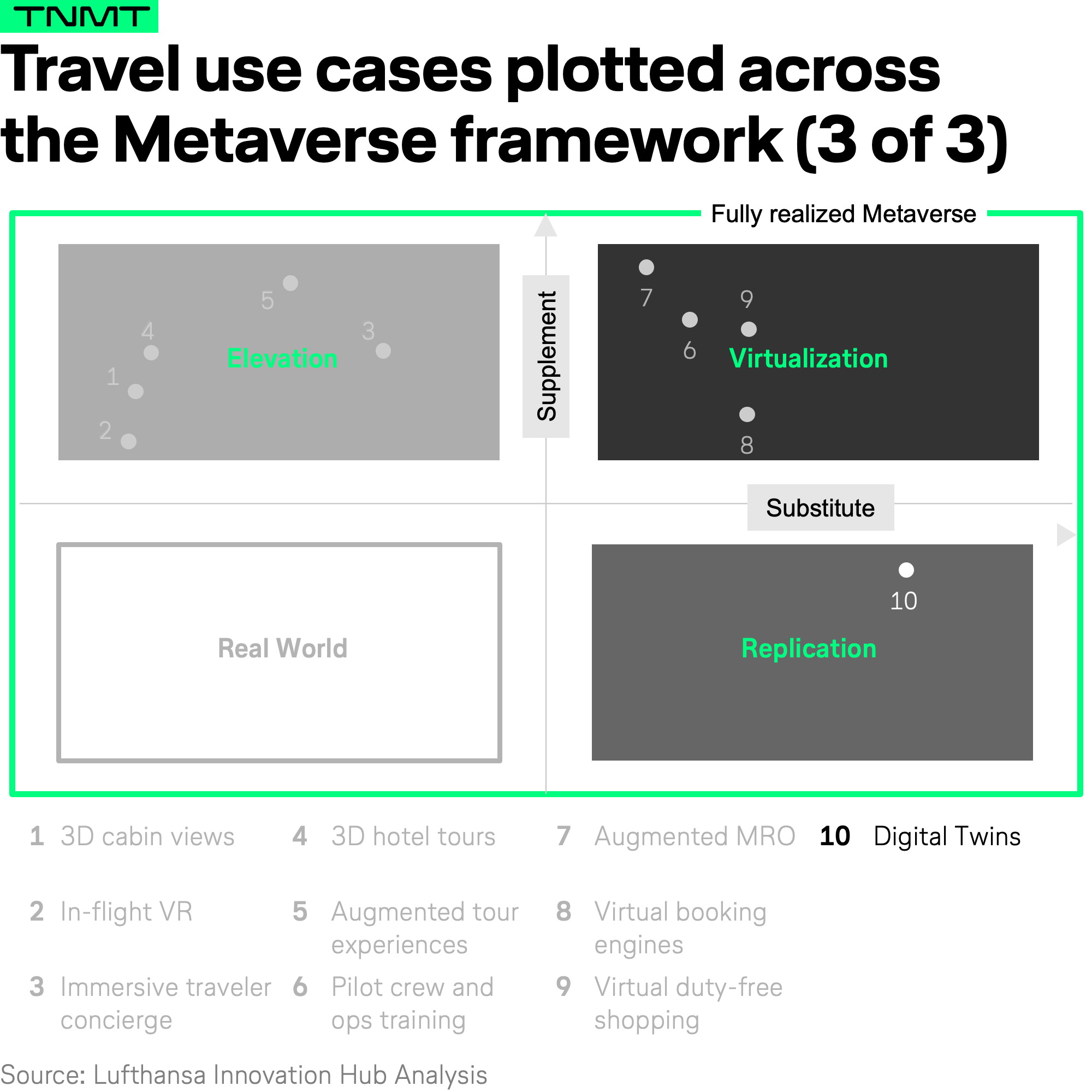
In aviation, digital twins are typically created to better understand how aircraft parts, like engines or engine components, behave under specific conditions. The physical engine or engine part will be equipped with sensors. While in action, these sensors collect information on how the engine is functioning and feed this data into the virtual replica in real time.
The virtual model can then determine how the engine is operating, and when it may need maintenance again and can make more accurate predictions on how the engine would behave under extreme conditions.
And again, the use of this technology is more ubiquitous than you might think, with Rolls Royce, a leading manufacturer of aircraft engines, Boeing, and Airbus, all utilizing this technology.
Travel’s Future: Metaverse and real-world synergy
As we have shown, today’s experiments towards a travel metaverse future are isolated experiments mostly leveraging VR, AR, and digital twin applications. These applications are nowhere near the minimum of what the fully immersive metaverse concept actually means.
Will we ever get there in the travel context?
And to take this to the ultimate level, will people eventually give up traveling at some point and join an alternative reality virtually to explore the world? At this point in time, it’s more than unlikely.
Human curiosity and the desire for authentic connections with people, places, and cultures drive our innate love for exploration, which cannot be entirely replicated in the digital realm.
However, the concept of a fully immersive metaverse experience complementing real-world travel offers an inspiring vision for the future, where technology enables us to enhance and enrich our experiences in ways previously unimaginable.
Metaverse travel could open up a world of possibilities, allowing people from all walks of life to participate in extraordinary experiences that may have been inaccessible otherwise. Imagine virtually attending the Rio Carnival, dancing alongside the vibrant parade from the comfort of your home, or being transported to the Great Barrier Reef, witnessing the mesmerizing underwater ecosystem up close through virtual reality.
Early examples of this exciting future can already be seen today.
One such early adopter is, for instance, Japan-based Dokodemo Door Trip, a provider of 3-D immersive tours. Using VR headsets and 3-D imagery, customers can take part in tours spanning many of the world’s tourist destinations, some of them free, some of them paid (prices start at $5 USD). This may seem like a very abstract idea; however, there are certain benefits to this concept.
- For instance, one of the first tours filmed was reportedly one of the turtles nesting in the Ostional Wildlife Reserve in Costa Rica. This rare natural phenomenon in which hundreds of sea turtles nest on one specific mile of beach is only open to visitors under strict conditions.
- Hence, creating a virtual experience has concrete benefits for both travelers wishing to witness this rare incident and for the wildlife reserve that wishes to preserve and maintain tourism to the highest standards of sustainability.
- Importantly, Dokodemo’s business model is supported by allowing tour guides to film the experience themselves and earn additional income for every participant (many of whom may not have been able to take the trip in person).
- Also, being a subsidiary of Japanese machine-learning-based translation company MetaReal Corp, the metaverse tour operator provides real-time translations for all communication that happens throughout the virtual tour, making it easy to exchange with guides and fellow travelers.
While the metaverse offers these captivating virtual experiences, it will not replace the thrill of physically attending events or exploring destinations. The excitement of being in a bustling local market, the sensation of sand between your toes on a pristine beach, or the aroma of freshly prepared street food cannot be replicated through digital means.
Instead, the metaverse and real-world travel can work in harmony to support our real-world experiences throughout the travel journey—from allowing you to book your hotel room and related ancillaries in a virtual environment true to reality, then supporting your trip to and through the airport via AR-enabled wayfinding, to providing real-time translation support at your destination through the use of an AR or hologram-based transcription service.
Picture visiting the Colosseum in Rome and using augmented reality to see gladiators come to life, or walking through the streets of ancient Pompeii, witnessing its history unfolding right before your eyes. The blend of real-world exploration and immersive virtual elements will create unforgettable, multidimensional, and, importantly, more seamless experiences for travelers.
As we look towards the future, the metaverse and physical travel will coexist and enhance our lives in unique and complementary ways. This exciting fusion of the real and virtual worlds will not only break down barriers but will also ignite our collective imagination, expanding the horizons of what is possible in travel and human connection.


